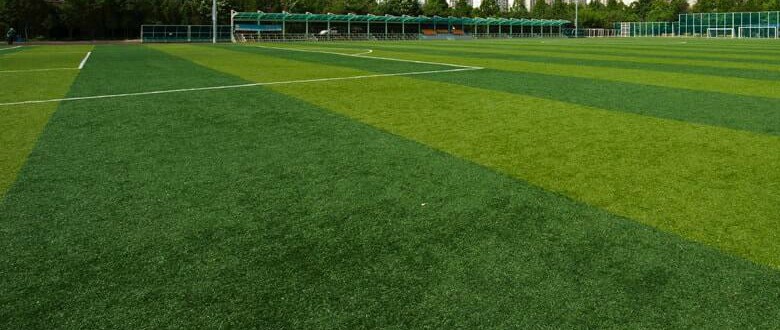Maintaining an artificial field is crucial to field performance. Poorly maintained fields will develop hard spots, or worse, areas that are scorched and melted due to neglect. The best remedy is a routine artificial turf maintenance schedule. If you lack the experience or equipment, Artificial Grass Pros can help.
Artificial turf fields are expensive after all. The last thing you want to do is ruin a six figure investment. Poor maintenance causes big problems for your field. Take a look at the list below.
Common Issues Associated with Poor Artificial Turf Maintenance
Every time your field is used, it receives more wear and tear. This is normal, it can not be stopped. However, neglecting to maintain it will result in a few issues for you.
Hard Spots. The infill layer gets compacted a bit with time and use. This happens for a variety of reasons. Players deposit dander and debris on the field with every play. If ignored, these can create thatch which prohibits draining. Poor draining can cause bacteria to grow. Slow drainage will cause the infill underneath the turf to compact, causing hard spots. These spots increase the likelihood of player injury.
Soft Spots. As the infill moves around due to athlete traffic, soft spots or divots can occur. These provide the perfect recipe for lower extremity injury. It is easy to turn a foot or roll an ankle in pits that remain unnoticed until it is too late. Plus, if these areas put stress on a location where two pieces of turf are joined together, you could be faced with the next issue on our list.
Seaming. Heat may cause seam edges to curl. It may also cause portions of turf to melt if things like water bottles or plexiglass covers are left lying around. These objects act as big magnifying glasses. They concentrate the sun’s heat and can be costly if not detected early. On the other hand, seam issues are a much easier fix.
Regular Turf Maintenance is the Best Prevention
This is why regular turf maintenance is so important. Not only does it keep your field looking and performing great, it may be required to maintain your warranty. Here are a few regular maintenance items you should be performing on your athletic field.
Sweeping. This is essential artificial turf field maintenance 101. Consistently sweeping your field with a professional equipment (equipped with static tipped nylon brushes) does a few things for your field. First, it will stand the yarn fibers up nice and straight. With constant use, yarn fibers actually get shorter. If left laying on their side, your field will perform poorly. Athletes will have a hard time getting traction with their turf cleats. Standing the fibers up allows for better play.
Second, sweeping removes surface debris. As mentioned earlier, unattended debris can lead to thatch, which leads to poor drainage, ultimate speeding up infill compaction. Finally, sweeping redistributes the infill so the playing surface is nice and level. It is important to note you should make multiple passes over the field in different directions to ensure the infill is evenly distributed.
Decompacting the Infill. We cover a lot of this information in another section, so we will be brief here. Essentially, you want to decompact the infill on a regular basis to remove debris and loosen up the rubber crumbles. Passing over the field with an aerator will decompact any minor spots, but the entire infill will need to be addressed at some point. For more on this, read our decompaction post on Prolonging Artificial Turf Athletic Fields.
Spraying. Regularly spraying your field with water cleans it of surface debris. This should be a part of regular field maintenance. It keeps your field clean and free from debris. Plus, it slows the compaction process.
How Often Should Maintenance be Performed?
This is where Artificial Turf Maintenance can get tricky. Scheduled maintenance depends on factors like:
- Usage
- Weather
- Type of Field
Generally speaking, you should regularly brush the surface of your field to remove debris. Some manufacturers recommend doing this after 80 hours of use, but many field owners do so before each game. Aeration is typically reserved for once per year under many maintenance plans.
Artificial grass pros can split up service plans into categories like standard, advanced, comprehensive and custom. This allows field owners to choose a plan that best suits their budget and needs. However, many routine tasks can be performed by the field owner as good preventative maintenance. They are:
- Regularly brushing the field to keep yarn fibers nice and straight
- Perform inspections to spot trouble spots and make repairs as needed
- Check infill levels consistently to ensure safety and performance
- Keep the surface free of debris
Consult Artificial Grass Pros for Help
Of course, you can always give us a call. Artificial Grass Pros can help you come up with a plan to keep your field looking great and playing safe. We will go over the specifics of power brooming, aeration, decompaction, spraying and Gmax testing. We will also make sure you are checking for things that can sneak up on you like seam failure, mid panel tears, and separating inlays of markings. Most issues are usually easy to repair if detected early. Heavy duty turf glue will put your field back in the game.
If your field has melted or scorched spots we will work to address them with you. In addition, Artificial Grass Pros will help you understand the root cause of the issue so you can devise a plan to prevent future occurrences. Call us today if you have questions. Our staff our knowledgeable and ready to help. Ignoring artificial turf field maintenance is something you can not afford. Doing so would be a costly mistake.

